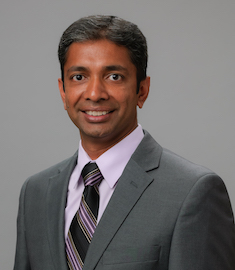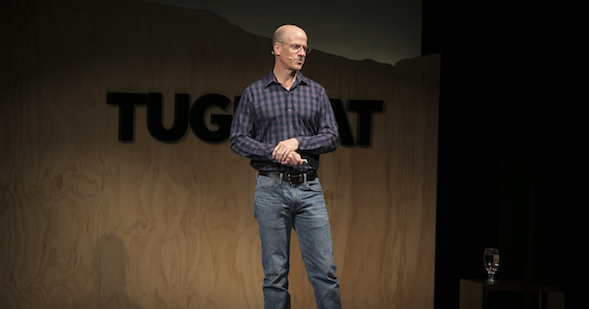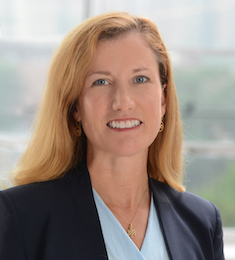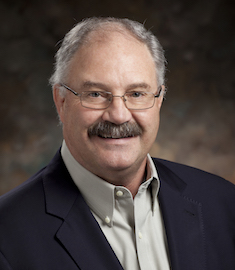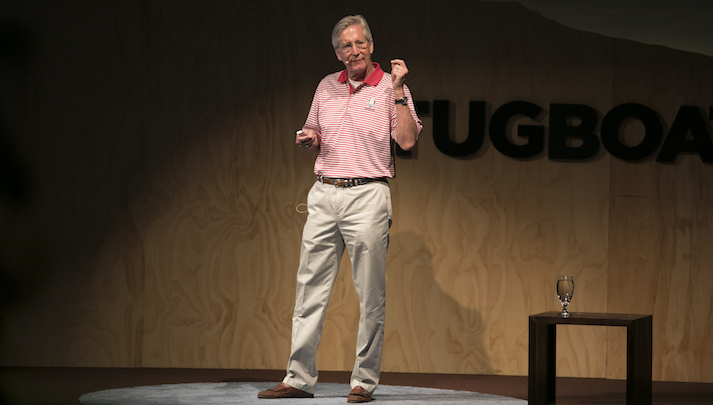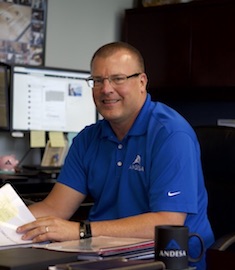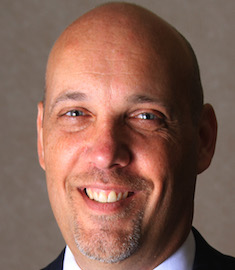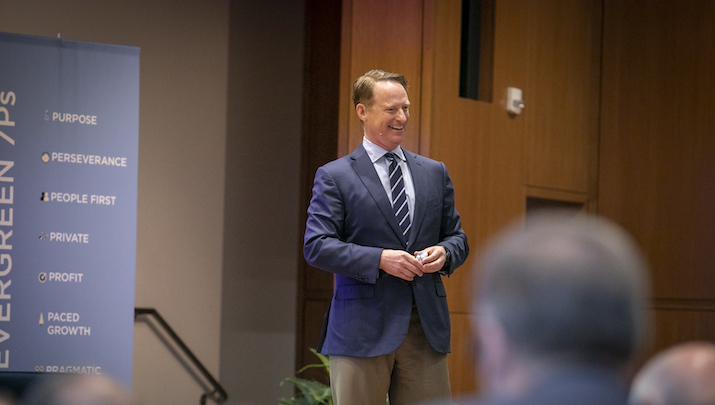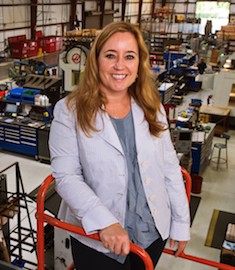Happy New Year from Tugboat Institute
Dear Evergreen Journal readers,
Happy New Year! As we head into 2019, we are grateful for the learnings and experiences we shared in 2018. We are excited by the momentum in the Evergreen movement.
The Year in Review
Tugboat Institute membership grew by 30 percent in 2018, broadening our membership to include new industries and new geographies.
In January, we launched Evergreen Journal Quarterly, a print publication that includes Evergreen Journal articles and additional content we create each quarter. The magazine allows us to regularly curate the expertise and experience of our community in a new way, offering members and a wider audience a valuable, Evergreen collection of best practices, insights, and information.
In June our members came together in Sun Valley, Idaho for Tugboat Institute Summit 2018. I was happy to launch the week’s talks by sharing the story behind the phenomenal success of In-N-Out Burger, an exemplar of Evergreen principles, including Private, Paced Growth, and People First. Talks by members ranged from heartfelt experiences of personal development to tactical growth strategies to best practices in building culture for the long-term. Across the talks, conversations, and activities, we found inspiration, lessons, and valued connections.
In August, we moved our headquarters from Palo Alto to our new office in Sun Valley. We are spoiled to be working with a view of world-famous Bald Mountain from our conference room, and we welcome any visitors who venture to our peaceful mountain town to stop by and say hello!
We also launched our first online Tugboat Seminar in August, expanding upon member Joe Motz’s Summit talk, and we followed that with two additional seminars in September and November—hosted by member Tom Rosztoczy and Tugboat Fellow Spencer Burke, with Kim Sheehy, respectively. The seminars were met with enthusiastic support, and we are happy to be planning six additional seminars for 2019.
In October, we traveled to St. Louis, Missouri, where members were graciously hosted by Andy Taylor, Executive Chairman of Enterprise Holdings, at the company’s headquarters for our fall Tugboat Institute Exemplar visit.
Our inspiring days at Enterprise were followed by a wonderful opportunity—facilitated by Tugboat Institute Fellow Spencer Burke—to share the Evergreen story with the wider community of St. Louis at the Olin Family Business Symposium at Washington University.
Looking Ahead
We are heading to Chicago, Illinois in April, where Tugboat Institute member Robert Pasin, Chief Wagon Officer of Radio Flyer, will host us for our Tugboat Institute @RadioFlyer Exemplar event.
In June, members will again gather in Sun Valley for Tugboat Institute Summit 2019. We are excited to be hosting the event at the recently completed Argyros Performing Arts Center, an amazing new venue perfect for our group.
New in 2019, we have launched a Tugboat Institute YouTube channel, and I am in the beginning stages of launching a personal blog to offer Ideas and perspective about Evergreen practices.
In addition to these programs, experiences, and new content platforms, we are investing time and resources to expand the Tugboat Institute experience to members’ key executives and family members. The Evergreen Conference, developed at the request of members, is planned for Dallas, Texas in spring of 2020 and will be open to members’ families and leadership teams. We have also been working to expand and enhance our Certified Evergreen program to offer a rigorous certification process, based on the Evergreen 7Ps. While both the Evergreen Conference and Certified Evergreen program will initially be offered to members, we anticipate both will be made available to other Evergreen companies.
Final Thoughts
As we head toward a new year, we are optimistic about the positive impact of Evergreen companies on their employees, their communities, and on society. While this past year has presented some uncertainty—through this past fall’s downturn in the stock market and concerns over trade—we feel confident that the year ahead will offer Evergreen companies ample opportunity.
At Tugboat Institute, we are looking forward to continuing to support members and the Evergreen movement. As we navigate the year ahead, we will continue to embrace the long-term view.
With Gratitude,
Dave Whorton & The Tugboat Team
The Transformative Power of Why
When I stepped into my role as CEO of our Evergreen population health management company, Telligen, in 2011, we were at a crossroads. As co-founder of what was now a new business emerging with the assets of a predecessor company where I had been an employee, I knew I was facing a period of significant challenge—but I had a few ideas. When I assumed leadership, we were losing clients, revenue, and employees. The exodus of very talented people was especially devastating because the real value of our type of business is in the people.
I knew that to move forward, we had to answer the most basic question: Why do we exist?
At that point, the company had been pursuing a wide range of work, and neither employees nor clients were able to articulate a connection or clear Purpose that bound the pieces to form a whole. Employees may have identified with a specific domain of work or a specific client, but it wasn’t clear why we existed as an entity.
And yet, I knew these disparate pieces could be brought together to form a company that would reflect our passion for transforming lives and economies through better health. I had a sense for the incredible experience of our people and the products and solutions we had built and could continue to create as a company. So, rather than quickly jumping into how to fix sales or account management or financials, which were all jockeying to be top of mind, I knew we first had to find our center and define our Purpose.
Without the resources for an outside consultant or facilitator, we started internally by asking questions and finding focus. I started the conversation by asking the negative question: “If we didn’t exist as a business, would anybody miss us? What would be different? Who wouldn’t get something they needed?”
As we worked through that exercise, employees responded, reflecting their individual projects and clients’ needs. Answers ranged from, “If we didn’t exist, then a cancer patient wouldn’t be able to get case management;” to, “if we didn’t exist, this provider wouldn’t be able to implement an electronic health record;” to, “if we didn’t exist, this nursing home would not be able to ensure the best quality of care to loved ones.” Everybody was touching the elephant in a different place—circling around one another as though inhabiting different planets and speaking different languages.
But amidst the different answers, a strong common thread emerged: Each project, each piece of work was, in its unique way, moving people to better health, and together we were helping manage the cost of healthcare. We had found our shared Purpose. With that grounding work complete, we moved on to develop a mission and vision by asking: “What would we look like if we did things really well? What would that mean to our clients?” With our Purpose defined, the vision came naturally: We want to improve people’s lives and fix the U.S. economy that is so negatively impacted by high healthcare costs.
One of the first benefits of this new foundation was to align our work with our Purpose. Now, in reviewing existing projects and prospective clients, we were able to easily discern if their goals were aligned with what we wanted to be as a company. If they were, we were able to quickly recognize that and say, “yes, what you’re trying to solve aligns absolutely with what we do, and we want to do this job.” On the flip side, if we were presented with a project that did not reflect our Purpose, we could say, “no, that’s not what we do; that’s not who we are.” Knowing what work to go after, what work to keep, what work to grow, and who we needed on the bus to do the work and move us down the road were all early results of our newly defined Purpose.
As we became increasingly centered as a business, we attracted new clients who aligned with our Purpose, and existing clients noticed our clarity and found a deeper connection between our work and their goals. With increased sales, the business’ top line changed, which created all sorts of good things, as we were able to slowly open up opportunities for professional development, create new products, and improve existing systems. Prioritizing these internal investments came pretty quickly with our newfound Purpose because we knew now what we were about. Instead of fragmenting investment with the hope that something would click, we knew which investments aligned with our Purpose and would move us toward our shared goals.
As we moved forward, directed by our Purpose, we also honed our language and were able to clearly articulate who we were and how we were meeting our goals internally and externally. Internally, we were able to share success stories and client acquisition in a way that allowed employees to connect those wins to our mission. Externally, we were able to connect with clients more efficiently and more deeply. And, our recruiting efforts improved as hiring managers began to use the new language of our Purpose and attract a different kind of talent that was more connected to the company’s Purpose.
Now, seven years later, I can say that our Purpose is part of our DNA. I have seen how a business can be transformed when you are clear about your Purpose and understand why your company exists. On a personal note, as an Evergreen CEO, I continue to feel the power of the work we’ve done. When I am facing a challenge, it’s my deep belief in our Purpose that keeps me going: I know exactly why we exist and how we are changing lives. That makes it all worthwhile.
Jeff Chungath is the CEO and a founder of Telligen, a 100 percent employee-owned population health management company with a mission to be the company that fixes what ails the healthcare system in the United States through health management solutions that drive better health and value to purchasers of health benefits.
Growth through Acquisitions—A Learning Journey
Paced Growth is an essential principle of successful Evergreen businesses. While growth can be organic or accomplished through new ventures, some Evergreen companies will choose to grow through acquisition.
Tom Rosztoczy, CEO of Stotz Equipment, has guided his Evergreen company to grow from three John Deere dealerships in Arizona to 25 stores in eight Western states over the past 20 years. In his presentation from the Tugboat Institute Summit 2018, Tom shares the key factors of that successful acquisition journey and the core values that are integrated into each new acquisition to continue to propel his Evergreen business forward.
When It Comes to Success, There Is No Checklist
I am a lifelong educator, committed to ensuring that every child has the opportunity to choose the life they want to lead. It all starts with immersing them in an excellent school experience. My first job after college was at an alternative school for students who had been expelled from other institutions. The soundtrack of that school was people screaming at one another. It was not a good place for children.
This experience 25 years ago, and my inability to make change in that toxic environment propelled me to pursue a graduate degree in education, and, ultimately, to a career in teaching, leadership, and program development for schools in underserved communities. Throughout my career, I have been guided by the revelation that when everyone really intentionally thinks about what children need to thrive—and the unique types of support their circumstances may require—we can truly change lives.
But changing lives is not accomplished by checking boxes or following a blueprint for academic success. Anyone can follow instructions in a playbook; it’s when culture and values are brought to life every day by the players and the coaches on the field—the teachers, the administrators, the leadership—that students surpass expectations. In the most engaged, successful academic settings, people literally breathe the culture.
From 2012 to 2017, I served in several roles at Success Academy Charter Schools (SA), the largest and highest-performing free, public charter school network in New York City. There are no tests to get into the schools, and students are admitted by lottery. In 2017, 95 percent were proficient in math and 84 percent were proficient in literacy, based on the scores from the New York State Test. That’s compared to a 40 percent proficiency rate in New York state and New York City. SA’s closest peers are the state’s richest school districts, though 73 percent of SA’s students are economically disadvantaged. The starkest contrast is this: when I was a principal in Harlem, 94 percent of the children in my school were proficient in math; our school was in the same school building with another public school, where only 7 percent of the students were proficient. Same neighborhood, same community, same building—vastly different results.
So what’s the difference? When professional development is threaded into the fabric of every day, it means leaders are having conversations with teachers about the impact of effective instruction, studying student work and planning together, then coaching and giving feedback, to ensure all students are being held to high standards. This People First approach is hands-on, and there’s an obsession with practicing and honing because it’s motivating to get better every day and to grow. This culture of mentorship, where leaders are consistently engaging in observing, evaluating, and providing a cycle of rapid, bite-sized feedback is transparent and normalized. It’s understood among team members that a principal’s role is to make junior leaders and teachers the best they can be, just as it’s a teacher’s job to ensure that each student finds success.
As your manager, I don’t want you to fall short of your goals; I want to push you to get there. I believe everyone can grow. You don’t always know what students need right away, but we work to get them there, and the same approach can be applied to teachers and to leaders. Throughout the organization, we should always be asking, what am I doing to make sure that my people are successful? A continual cycle of feedback and coaching, along with hundreds of hours of more formal training— core values, classroom management, curriculum planning, interpersonal communication skills, creating exceptional learning environments, time management, to name a handful— lead to consistent results from class to class. By listening for any challenges, observing and diagnosing, offering feedback to work toward a solution, we teach one another how to be better. This directly contradicts the cultural norm of most schools, wherein a visit from the principal to a teacher’s classroom is seen as a sign of failure.
Throughout my career, I’ve worked with many schools and educators who strive for the success we found at SA, but not many—if any—have been able to recreate the experience and achievement that lead to the same outcomes for students. They may implement similar curriculum, classroom processes, and facilities models—all items that can be captured in “checklists,” but that isn’t enough to achieve the same remarkable level of excellence. The difference is culture.
Successful school culture stems from a deeply ingrained Purpose: a tremendous confidence in the children, and the drive to provide them opportunity. All students, particularly those from underserved communities, should be offered the same opportunities to succeed in life as students attending the most advantaged private schools. The culture can be further developed by Pragmatic Innovation, which keeps us continually looking at curriculum, processes, protocols, and facilities to ensure we are truly creating opportunities for our students.
On a practical level, and much like a great manufacturing company would do, we look to ways we can innovate and improve processes to make our time with students as productive and efficient as possible. On a small scale, students in grades K-2 to wear shoes without laces because we’ve learned that when they do, teachers spend an inordinate amount of time tying shoes instead of teaching. We consistently ask, how do we maximize our time? This carries over to the design of the classrooms, where everything is strategically placed— collection bins for student work, backpack hooks and boot bins. The efficiencies also encompass what people repeatedly do— routines for passing out and collecting materials, giving quick directions using “economy of language,” using hand signals to communicate “I need some water” (crossed fingers in the air), or “I don’t understand that vocabulary word” (two fingers raised in a “V”), all of which avoids wasting time in order to maximize learning and creates a sense of urgency about all of the engaging work we have yet to do.
Finally, when everything comes together and culture becomes the air we breathe, our students develop something critical beyond academic achievement—they develop resiliency. This essential character trait isn’t measured by test scores, but it becomes their most valuable achievement. Because resiliency is what will keep them in college once they get there; resiliency is what will push them to work through challenge in work and in life. It is the intrinsic motivation that will help them succeed in a way that no textbook or curriculum can deliver. If we are able to develop that resiliency with academic achievement, then we have been truly successful.
So, while it may be fairly straightforward to replicate the operational checklists of an exceptional school, it’s only half the equation. The other half is the soft stuff—the critical cultural elements: belief in students and teachers, extensive training and mentoring on how to do one’s job well, continuous improvements throughout the organization, and encouraging and rewarding character. Without our culture, we would just have a bunch of lists.
Meghan Mackay has served for over two decades as an educator and education leader. She was Managing Director of Schools at Success Academy Charter Schools, as well as Managing Director of Programming for the Education Institute and Principal of Success Academy Harlem 5.She has also taught middle school and high school literature and writing, developed educational software and student information systems, written curriculum, and facilitated professional development for principals. She has helped found five high-performing charter schools in Boston, Trenton, and the Bronx. In 2018, Meghan, together with several former SA colleagues, opened Zeta Charter Schools, a new network of schools serving New York City children. She also launched an operating foundation, LeveragED Foundation, to bring expertise and capital to school networks that seek to optimize the implementation of instruction and professional development.
Growth is Not a Goal
At POWER Engineers, we don’t use the word “growth.” In fact, at one time, that word was not allowed to be spoken during company meetings. And yet, as a global consulting services and engineering firm, we average a 15.6 percent annual growth rate.
So, what’s our secret?
First, a little background on POWER. We were founded in 1976 by three Idaho engineers and are now an employee-owned C-Corp with a team of 2,500 worldwide and annual revenue of $450M in 2017. In fact, we’re the largest power delivery consultant in the United States—not bad!
As employee owners, we’ve achieved this success not by focusing on growth, but by focusing on what our employees, clients, and shareholders care about most. It’s what we call “mutual success,” and it has led to a steady, paced growth for over 20 years.
Here are four key points to our “Paced Growth” philosophy.
We’re motivated by opportunities.
First, in our view, growth is a result, not a goal itself. We don’t believe that growth expectations are the driver for our business—market strength is. So we focus on more meaningful business concepts like “opportunities,” “market changes,” “new technologies,” and “Profit.”
We ask, “What’s the barrier to entry? Who’s the competition? How can we compete? Do we have an internal champion?” If we determine, for example, that a certain project makes sense to us, we take it on. As employee owners, we’re empowered to make those decisions.
So instead of being driven by growth expectations, we’re motivated by the opportunity to chase fun, challenging projects.
We make sure we’re sustainable.
Our next overarching goal is to provide a long career for our people. Our fundamental requirement has been to maintain strong margins (our charter says we must have 10-15 percent income from operations [IFO] on gross revenue).
So, as we evaluate projects, we understand that if we don’t make money none of us will have a job. And that means we won’t be able to continue to build this company.
As employee owners, we make sure to be transparent with these decisions. That’s why we publish our financials every month to every employee in the company and have done so from the beginning—we tell people what we do and why.
We plan from the bottom up.
Third, we practice a bottom-up approach. Each year, each of our departments delivers a market analysis to the executive team of what they think they can realistically do in the coming year.
We tell people: “If your market is in a downturn or is going to crash, you have to tell us. If you did $50M last year at 10 percent and you’re going to do $40M at 6 percent this year, we have to know because this is how we budget money to move the company forward.”
Our managers lead the effort from the bottom up. Of course, some groups “sandbag” and others are overly optimistic, but we trust our managers and the information they present. The exec team then calibrates and adjusts a bit and plans accordingly.
Because we practice transparency, the results of this planning are on display for everyone to see throughout the year. Peer pressure is key to the success of this model because nobody wants to look bad in front of their friends!
We’re geeks at heart.
Finally, and perhaps most important, as engineers, we’re geeks at heart, and our work is our fun. We have intentionally built a culture with that directive at its heart.
Since the 1980s, our slogan has been: “Do Good Work. Have Fun. Make Money.”
And it’s not just the engineers and consultants who feel this way—the entire staff, from our receptionists to our project managers understand that what we do is important and interesting.
It’s our commitment and love for our work that moves us forward.
Postscript
In all fairness, our success story has not been without its challenges.
For example, in 2001, ENRON collapsed the energy market. At the time, they were a big client. That event singlehandedly took our revenue from $99M to $75M and our staff from 735 employees to 500.
While that experience was difficult, we came back the same way we have moved forward since 1976—through steady, paced growth that is a result, not a goal—fueled by fun and inspired by challenge.
Jack Hand is the Chairman of POWER Engineers, a global consulting engineering and services firm specializing in energy, facilities, and environmental.
It's a Family Tradition
Bobby Jenkins grew up working in the pest control business his father built in San Antonio, Texas, which has since grown to become ABC Home & Commercial, a company with multiple locations throughout Texas, which Bobby and his two brothers own.
In this presentation at Tugboat Institute Summit 2018, Bobby shares the story of how the Jenkins family has navigated succession and multi-generational ownership to this point, describing the key factors in their success and his hopes for the future of the business.
Peaks and Perseverance in an Evergreen Journey
As with many aspiring CPAs, my career goal had been to take on the challenge of becoming CEO at a company. I had a number of opportunities throughout my career as a CFO to achieve that goal. Since most of those opportunities were “turn around” situations, each required complete commitment and devotion to the task at hand, which was to save the company. However, as a life-long learner, I was my own worst enemy. Invariably, in five to seven years, the challenge and the opportunity to learn new things diminished, and I felt an “itch” for the next challenge. That itch brought me to Andesa Services in 2005 as CFO.
In the case of Andesa, there was no “save the company” urgency. Andesa was a stable, 22-year-old, privately held provider of technology and services to the life insurance industry. Predictably, after five successful fiscal years, the same career decision point loomed in the back of my mind. Time to move on?
Unexpectedly, in December 2010, I was offered the opportunity to lead this extraordinary company as CEO. There was a moment when I believed I had reached the pinnacle of my career. My career aspiration had been achieved!
That exuberance was short lived. In the same Board meeting where I was offered the opportunity to be CEO, management informed the Board that the company’s largest client had announced its exit from the market and would no longer offer the insurance products administered by Andesa. This announcement was a tidal wave that put significant revenue at risk. So much for basking in the glow of a career milestone.
At that meeting, Andesa’s Board deferred approval of a budget to allow management time to assess the situation and financial impact as well as prepare a plan for a reduction in force. In one meeting, my mental state descended from the mountain top into the valley of reality and reaction. For Andesa to maintain its long-term, Evergreen perspective, there was no choice for the organization but to make short-term decisions and operate in turnaround mode until we had weathered this storm.
For only the second time in the company’s history, performance and projections led us down a path that contradicted our People First culture. I was keenly aware that culture can collapse quickly, especially when profitability strains the ability to invest in a healthy environment. Self-consciously, I questioned my own leadership talents. Could I lead my Andesa teammates through this difficult period to a brighter, long-term future? It was baptism by fire. I knew my first conversation with the employee team would set the tone for our future together.
I began that initial team meeting by expressing appreciation for our exiting CEO and wishing him future success. I acknowledged the confidence that the Board had placed in me, and I shared how those conversations had been some of the most affirming discussions in my life. I then quickly pivoted the conversation with the following statement: “But this isn’t about me—this is about Andesa Services.” I went on to highlight excerpts from Good-to-Great highlighting the discipline needed to confront challenge.
Because there was no question we were facing challenge: The company had underperformed plan in 2010; 28 percent of its revenue was now at risk; plans for investment in new product lines would be deferred; and, on top of all that, we were undergoing a major leadership change. I noted that, “We may need to go sideways or even backwards for a while in order to move forward—but go forward we will.”
I emphasized our strengths, not our fears: our fiscal soundness; our reputation for service excellence; a strong technical environment that requires constant modernization investment; and, an ethical work environment made vibrant by a set of core values lived by our teammates. I asked each teammate to look at the faces of their colleagues around the room that day, to recognize that this group of individuals is the best in the world at understanding, processing, and administering complex life insurance products and policies.
Despite my best intentions to inspire, the reality of the situation was still brutal. Layoffs were emotional and difficult. Many team members questioned the organization’s culture and financial stability. In the ensuing months, we witnessed the departure of many talented individuals. But, those who remained stayed focused on their work and never wavered in our commitments to our clients. They preserved the Andesa culture by supporting one another through a difficult time.
Three things sustained me through this transition. First, I believed: I had a deeply rooted trust and confidence in the people of Andesa Services, and the number one goal during this time was to ensure we preserved our core values and culture which had led to 27 years of growth and success. A reduction-in-force cut to the heart of our vision and sense of community, and I made constant reminders to myself and the team that who we are was significant.
Second, I called on my faith: My journal from those days is filled with prayer requests—some answers were clear, and some requests were answered in ways I have yet to comprehend. Remaining grounded in my faith during those trying days was paramount for staying positive and confident we would persevere. Finally, I focused on nuggets of good news: Small daily wins dominate my journal. Sometimes a staff member shared a positive comment—the progress on a project or a hint of possible new business opportunity was enough to provide encouragement. Those daily moments reinforced my faith that we would prevail despite simultaneous daily doses of brutal reality.
Today, Andesa is a financially stable, privately held, 35-year-old company that is partially ESOP owned. We are investing in new technologies, product lines, and service offerings. We are marching toward becoming a 100 percent ESOP-owned company. Our existing clients continue to add new products each year, and we are adding new clients to our insurance administration eco-system.
The journey for an Evergreen company involves some wonderful views from the peaks, but it also requires endurance through the valleys. The long journey to “Forever” is rarely (if ever) straight and paved.
Andesa’s ability to persevere provides us the opportunity to live into our Forever Vision. The lessons learned from those first days in the leadership seat continue to drive me today. In corporate communications, we are always careful to share the reality of our situation and to emphasize our strengths and the prospect of a positive future. Most of our message focuses on our culture, purpose, and the resolve of the Andesa spirit and its team members.
And, by the way, I learn something new from my teammates every day. My “itch” seems to have been cured.
Ron Scheese is President and CEO of Andesa Services.
Koffee with Kevin
I retired from the Navy as Commander in 2006, after 20 years of service. My Naval career included missions flying attack helicopters in Desert Storm, serving as a Navy test pilot, instructing pilots and astronauts at the Navy Test Pilot School, and ultimately retiring from a position as an acquisition professional, responsible for purchasing a new fleet of attack helicopters. In that final role, I managed an $11B program and oversaw a staff of 250.
When I made the decision to retire and began interviewing for positions in the private sector, my experience made me very marketable. But while there was a lot of interest from many different companies, I received offers that I felt did not reflect my value as an employee. In fact, I felt they were insultingly low. I knew my experience was extremely unique; as a Commander, I had been doing the work of a higher rank at a much younger age than is standard—with notable success. But when it came time to assess my value in terms of salary, potential employers were making offers based on my rank, not my true value.
As this experience unfolded and I became increasingly frustrated, I sought out mentorship and advice from others who had made the transition from a military career. Surprisingly, I found others, even those I considered friends, were hesitant to offer insight—especially about salary and negotiation tactics.
Ultimately, the process led me to start my own business rather than work for a company that did not understand my worth. Together with a good friend and fellow veteran, I launched AVIAN, LLC, a defense contracting company providing support to government and commercial clients around the country.
As we transitioned from our military careers and built our company, my purpose became clear: take care of people and do what is right. Driven by this desire to be of service and act with integrity, I hired every single one of our first 120 employees myself, meeting each candidate for coffee at a local coffee shop. These conversations allowed me to connect and to share my passion. Often, these meetings resulted in the potential employee telling me that they wanted to be a part of what I was creating. But whether they became an AVIAN employee or not, my goal was always to offer guidance and support during our conversation, providing the mentorship I would have appreciated during my own job search.
Over time, my reputation grew in the local marketplace, and I found myself approached by friends, acquaintances, and complete strangers who were leaving the military and seeking career guidance. People started calling me out of the blue and telling me that someone had told them, “you need to have coffee with Kevin.”
Today, 13 years later, I am still meeting five-to-six people a month for “Koffee with Kevin.”
These conversations span a range of topics, but, generally, people are interested in the same essential questions I had when I left my long military career: Where do I go from here? What’s my value? How do I approach this process and negotiate for my worth? Sometimes, they are interested in starting their own company and are seeking advice in that realm. Whether they are launching their own venture or stepping into an existing company, I appreciate the opportunity to share my experience and insight.
My guidance for veterans stepping into private-sector roles is to keep in mind that though they may be wearing business apparel in place of a uniform, it actually takes about six months to take the uniform off. I make a point to have an early conversation with employees joining my company from military careers, during which I provide counsel to ease this transition. I share with them that here is generally one central challenge in this move: the need for efficiency generally trumps diplomacy in task completion in the military—not so in business. I share the power of shifting perspective to appreciate the role of influence and negotiation in their new role. I tell them: Instead of being angry with someone, be fascinated with someone; instead of saying “I have a concern,” say “I have a thought;” instead of having issues, start having ideas. I make sure they know that they can get a lot done out of uniform through influence with thoughts and ideas.
If, as an Evergreen leader, you have the opportunity to hire a veteran, know that you are bringing in a professional trained to think critically, solve problems, and get a job done, propelled by a deep commitment to efficiency and excellence. And, recognize that you are uniquely poised to enter into a productive, fulfilling relationship with an employee who will look to you for leadership. Because more than any other principle, military culture is fundamentally based upon People First leadership, upon the foundation of respect and taking care of your people.
My advice for helping these new employees transition: give them a task and let them go. The task will be completed fast and exactly the way you want it to be done. You don’t have to micromanage. In the Navy, we call it “Commander’s Intent”—give them your intent, and they will make it happen. And, if any task seems to be bogged down, just send an email with the following in the subject line: “Message to Garcia”—that’s military shorthand for "take the initiative and get the job done right." You won’t have to ask twice.
As I reflect on the now thousands of conversations I have had the honor to have with men and women transitioning from the military—both those who have become my employees and those who taken other paths—I am humbled. It makes me feel good, and it never hurts to have friends. But, maybe most important, it also allows me to tell my story and helps me to back up and remember why I did this, where my passion comes from, and feel gratitude for my own journey and for the ability to pay it forward. All those cups of coffee have been a gift to me, and I look forward to a lot more time in the coffee shop.
Kevin Switick is a co-owner and president of AVIAN, a defense contracting company providing support to government and commercial clients around the country.
Introduction to Evergreen Principles
In this keynote presentation from the Fourth Annual Olin Family Business Symposium at Washington University in St. Louis on October 12, 2018, Dave Whorton shares the journey of discovery that led to his founding of Tugboat Institute and the Evergreen Movement.
Throughout his talk, he debunks common myths about business and contrasts them with the competitive advantage of Evergreens, and describes how Tugboat Institute is supporting Evergreen leaders and businesses today.
Pioneering a Leadership Team
As President of our family-owned Evergreen manufacturing business, Bishop-Wisecarver, I’ve recently completed work around identifying the core values that guide our company. The insights of that process have been illuminating. One of the core values that emerged and has really resonated with our team has been our “Pioneering Spirit.”
My ancestors came to California from Iowa in 1853 in a covered wagon. They persevered through many challenges during that journey and in the years since. In 1950, my dad, Bud, founded this company fueled by that same Pioneering Spirit, which is equal parts grit, perseverance, and vision.
In my own career at our company, I have drawn on those traits, and the spirit behind them, to create and nurture a leadership team that will carry us forward into the next generation.
When I joined Bishop-Wisecarver in 1991, it’s safe to say there hadn’t been a lot of energy devoted to developing company leadership. My dad was a natural engineer and tinkerer, and he spent his time on the production floor. While there was an executive committee that met as needed, they didn’t contribute to governance, and business operations were largely managed by a controller without input from any additional management team members.
After a career as a buyer for a division of Carter Hawley Hale, I joined the company to manage a short-term project and then stayed, moving into positions as office manager and marketing manager before assuming an operations role as assistant general manager in 1997. In each position, it was clear to me that the factional and highly siloed way we were functioning was inefficient and led to low morale. I made efforts to create communication and organizational improvements—from starting a company-wide newsletter to ultimately launching an operations committee and bringing the team together for the first time in the company’s history for regular meetings.
I became President in 1999 and continued to work toward innovating and developing structure and leadership within the company—without any precedent or existing framework to guide me. In 2004, I reached a turning point when I joined Strategic Coach® and learned the importance of working toward a self-managing company. The clear message, which I absorbed, was that your ability to innovate, be strategic, and grow a company is based on the strength of your executive team and their ability to create the necessary space for you to move the company forward.
With this directive in mind, I worked for years to develop leadership roles and a high performing executive team from within the ranks of our long-term employees. As a family company that has always valued length of service, it was important to me to honor that precedent. But in 2010, when I really looked at what it would take to elevate the team and create a dynamic that would allow me to grow and innovate, I realized there would have to be turnover. I needed to move past team members resistant to innovation and progress and bring in new people to change the culture and effectiveness of our team.
While it was incredibly painful and difficult to make those few tough choices to let go employees who were no longer contributing, the positive benefit was profound. I was able to create an incredible team. This team now includes people with invaluable, long-term, tribal knowledge—the VP of manufacturing has been with me for 20 years—and newer additions, like the VP of finance, who has been with me for two years. For us, turnover was necessary to upgrade and improve the culture.
As I have brought in new members to the executive team, I have done so with the perspective and self-knowledge gained through years of professional and personal development. Building an effective team has been the result of understanding my strengths and weaknesses as a leader, which has led me to surround myself with people whose skills and personalities allow us to effectively work together.
When I interview a potential executive team member now, I recognize that each candidate is choosing me as a leader, as much as I am choosing them as a member of the team. I know that my leadership style is action-oriented and hands-off; I need people who can create their own structure to get a job done. If someone needs a lot of reassurance and support, I am likely not the best leader for their professional path. I also tend to ask a lot of questions, to really prod my team for information and urge critical thinking; I need to know that my direct reports won’t see this as criticism and will have the self-esteem to thrive in this environment. Understanding these and other aspects of my leadership style has allowed me to be very clear with potential team members and to bring in people who will fit well with the culture we have created. And that’s essential because the only way to build a high-performing team is to build one that is right for you as a leader. Your team needs to support you, and, importantly, you have to like and respect one another. When mutual respect and understanding exists with all members, that’s when you get to that high-performing, self-managing team.
The team I have in place now has the skills and knowledge to allow me the space to think strategically, to pursue professional development opportunities that benefit the company, and to find some much-needed balance in my personal life. I am able to trust that the current leadership team can run the company while I’m away—and do it well. In fact, the company started to grow at our fastest rate when I gave the team the space and freedom to make decisions and take more ownership. And, the team understands that I am equally committed to their professional development and to supporting their needs. We’re in a good place.
Forging a new path as I have done in creating a leadership structure and a functioning executive team where none existed was not easy. There’s no doubt it has required a Pioneering Spirit, but the end result has been worth the effort, helping to ensure an Evergreen future for our company.
Pamela Kan is President of Bishop-Wisecarver, an engineering and manufacturing firm creating proven motion solutions that enable customers to solve their toughest industrial automation challenges.

